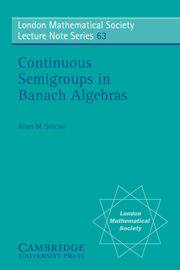Book contents
- Frontmatter
- Contents
- 1 Introduction and preliminaries
- 2 Analytic semigroups in particular Banach algebras
- 3 Existence of analytic semigroups – an extension of Cohen's factorization method
- 4 Proof of the existence of analytic semigroups
- 5 Restrictions on the growth of ∥at∥
- 6 Nilpotent semigroups and proper closed ideals
- Appendix 1 The Ahlfors-Heins theorem
- Appendix 2 Allan's theorem – closed ideals in L1 (ℝ+, ω)
- Appendix 3 Quasicentral bounded approximate identities
- References
- Index
3 - Existence of analytic semigroups – an extension of Cohen's factorization method
Published online by Cambridge University Press: 22 March 2010
- Frontmatter
- Contents
- 1 Introduction and preliminaries
- 2 Analytic semigroups in particular Banach algebras
- 3 Existence of analytic semigroups – an extension of Cohen's factorization method
- 4 Proof of the existence of analytic semigroups
- 5 Restrictions on the growth of ∥at∥
- 6 Nilpotent semigroups and proper closed ideals
- Appendix 1 The Ahlfors-Heins theorem
- Appendix 2 Allan's theorem – closed ideals in L1 (ℝ+, ω)
- Appendix 3 Quasicentral bounded approximate identities
- References
- Index
Summary
Throughout this chapter A will denote a Banach algebra with a countable bounded approximate identity, which will usually be bounded by 1. The main theorem of this chapter ensures that such an algebra contains a semigroup analytic in the open right half plane. This theorem is proved by an extension of Cohen's factorization theorem for a Banach algebra with a bounded approximate identity. In this chapter we shall discuss the properties of the semigroups that may be obtained by these methods, and shall investigate some applications of the existence of the semigroups. The proof of the existence of the semigroups is given in detail in Chapter 4, and is discussed there. The basic properties of the semigroup are stated in Theorem 3.1, and additional properties relating to derivations, multipliers and automorphisms are dealt with in Theorem 3.15.
Many of the properties of the semigroups given below are generalizations of those of the fractional integral semigroup in L1 (ℝ+), or the Gaussian and Poisson semigroups in L1 (ℝn). We should like the semigroups constructed in A to be as nice as possible: to have good growth, norm and spectral behaviour. In Chapter 5 it is shown that certain polynomial growth properties of the Gaussian and Poisson semigroups cannot hold in radical Banach algebras.
The semigroup properties of at are emphasised rather than the factorization properties, and all the semigroup properties that I know are included in Theorems 3.1 and 3.15. However in any given situation one is usually interested in only two or three properties of the semigroup, or of the module factor of x.
Information
- Type
- Chapter
- Information
- Continuous Semigroups in Banach Algebras , pp. 35 - 49Publisher: Cambridge University PressPrint publication year: 1982
